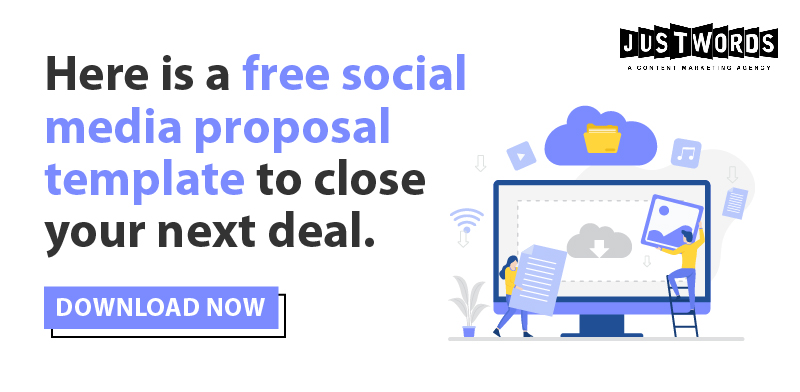When it comes to winning a client, there are no shortcuts. There! We said it. It requires a lot of dedication and work. And while looking for a specific type of client, you need to work around your way to collaborate with them on all the steps and move the brand together.
Social media proposals are the blueprint that you present to your prospective client outlining how you can help them achieve their goals. It needs to demonstrate an understanding of the prospective client’s requirements and how you are best equipped to fulfil them.
Along with facing numerous challenges like competitors in the market, providing ROI for your client, creating great content marketing for your accounts, and maintaining a good relationship and communication with each client, what matters the most when it comes to winning over a client – your understanding and interpretation of the brief that goes in the proposal.
Let’s go through the most important characteristics of an effective social media proposal that will make your proposal stand out from the rest of the crowd, and land you more social media management contracts.
Get the basics right with your prospective client and understand their expectations.
1. Business and marketing goals
Briefly identify the current goals of the business/brand, and accordingly align these with the marketing goals for social media. Collate and use this information to tie down the social metrics to their business goals.For example, engagement equals audience growth; conversions equals customer growth. While leads and conversions are straightforward, brand engagement and reach can be a bit tricky. Define the specific metrics you’ll track for these in your social media management proposal. Follower count, cumulative post reach, and cumulative engagement on a social channel can be used as a starting point. Eventually, you’ll have to summarize it to analyse the impact of your entire work on social.
Examples of Social Media goals:
• Generate x leads
• Generate x% of total revenue
• Increase targeted traffic by x%
• Increase brand engagement by x%
• Increase reach by x%
2. Take time to understand their industry
From construction to hospitality, from healthcare to fashion, our range of clients are quite diverse. With each new client comes new understanding of their industry and its workings. Whether your clients are B2B, B2C or both, understanding the dynamics of the industry they belong to will play a huge role in charting their social goals. Hence, invest proper time on research.
3. Study competitors
Find out who their business competitors are. It might be local businesses like other travel operators in the same town, or global brands. Focus on the competitors that actively use social media marketing to grow their business. After you’ve narrowed down the competitors, the next step is to gather data about their social media marketing activities.
4. What platforms are their competitors using
Every social media channel is different than the other, and the present audiences have specific reactions. For example, Twitter encourages short communication, while others, like Facebook or LinkedIn, promotes expressing opinions and comments on what’s happening at the moment in a rather detailed manner. Understand the importance of each channel to know how each channel is related to the goal you establish.
5. Prospective scenarios
The scale and size of each business and their experience with social media marketing will differ. Learn what they want help with and how much they’re prepared to invest. This could range from a single campaign to a fully managed service. Note down the timescale and budget for this project/ client.
Develop a long-term strategic social media plan:
1. Set S.M.A.R.T goals
In case you’re wondering, each acronym stands for Specific, Measurable, Attainable, Relevant, and Timely. State approximately three to five S.M.A.R.T social media goals. Each objective should specify the platforms, the metrics, and an end date. Clearly state when to measure the goal and what the metric is for success.For example: Increasing Twitter followers by 15 percent by the end of Q3.Don’t go overboard, and overpromise. Remember to always keep your goals realistic.
2. Research content topics and create a story
Getting engagement on your page(s), is directly proportional to connecting with your target audience. Planning your social media content delivery will keep your marketing on-point, thus, making it more likely to reach your business goals. Make sure to do the research right, and to keep your content as specific, relevant, and unique as possible. The hand that creates content will rule the digital world. From blogs to social posts to guest posts, it will go a long way in establishing authority, generating awareness, leads and even conversions. Don’t only talk about creating posts but also, how the posts are aligned with your overall goals and how you can eventually join the dots when you look back.
3. Project milestones and deadlines
Set achievable targets, and back these targets by drafting campaigns. Planning a campaign will help you set milestones that can be met during the course of your project. Evaluate every campaign post delivery, irrespective of their success or failure. Both successful and failed campaigns leave a lot of learning in their wake. Outline four campaign ideas you intend to take up during the project duration here.
4. Report on analytics
Translate analytics into a full blown analysis on how you’ve achieved your goals and map it back to the brand’s objectives. Create a reporting schedule, and make sure everyone in the team sticks to it. Some clients expect a weekly update, while others care fine with a bi-monthly report. Some clients will want a personal meeting, others may do it over a call or email. Set out report formats in advance and the reporting schedule, and run them through the client once so you can add or lessen any details they would not require.
Develop and set your goal-setting framework:
1. Clearly address the people involved
Make it very clear who does what, and exactly what the client can expect to receive. If you are an agency, then having an account manager is a big factor in establishing a comfort zone for your client. You’ll have to make sure that your account manager is someone with reasonable experience and is more a ‘jack of all’ kinds who can sound like a best friend to a client while protecting your agency’s interests.
If you are a freelancer, you’ll have to take up this job yourself. Sending regular email updates and having weekly calls can ease both you and your client into the schedule.
2. Audit and decide the tools you will use
While you don’t have to tell your clients the exact tools you plan to use, you can always speak about the benefits and features and what type of tools you plan to use. Several agencies use a task management tools like Asana, Trello or Basecamp, which takes the conversation out of emails and keeps everyone on the same page. You may sometimes have to teach your clients on how to use the tool too.
3. Plan how to get specific knowledge transfer from the client
In several cases, where the nature of the product or service is technical or niche, you’ll need to client’s help in picking the right words. In such cases, you’ll need regular briefs from them. You’ll also need updates on the company happenings, images, recruitment information etc. which can be shared socially.

4. Present your ‘A game’
Add in one insight or idea that’ll make your client sit up and take notice. This is the real deal. We highly recommend you do not send your proposal without this. You’ll need some industry, category, brand or product insight / problem that will become a strategy driver for your brand.
Also Read: Best Social Media Management Strategies During Times of Crisis
One thing that will truly make your proposal standout is the amount of customization you add in. For each of the points, use examples that the client can relate to clearly. This will showcase your depth of understanding their business, and in turn make you reliable in their eyes.
Finally, outline the specifics of the work you are proposing to do for the client, including a timeline and budget:
1. Scope of work and deliverables
This is one of the most important sections of your social media proposal. Bring your strategy into focus, backed by learnings from your audience research and social and competitive audits.Carefully audit and align these tactics with your social media objectives. Ensure it translates clearly to anyone reading the proposal what tactics you will use to accomplish that goal.
Also Read: Best Tips For Writing Great Social Media Post
Outline what specific deliverables you will provide to the client. For example, what Facebook posting strategy have you planned on adapting: will you actually create and post content yourself, or have the topics defined and get the content written from the client’s end?
2. Schedule and budget
Budget is always a stressful topic for the agency. You’ll have to calculate the cost of the resources you dedicate to a client and some of the additional work that crops up without notice when you are on a retainer. Many agencies outsource work to freelancers to save time, costs and efforts.
To ensure you don’t shock your client out of the park, try to break down the costs. This allows the client to see where their budget is being spent and then change the allocation if needed.
The sacred rule is to never undercharge because the work will always be more than you think. There will be unplanned meetings and calls. There will be a sudden email, which your resource will spend half a day on. At other times, the natural cascading effect of a campaign will make work overflow. There’ll be a Plan B that needs to be executed to get the campaign in line.

If you are a freelancer, you’ll be able to find near accurate answers on websites like Quora about what your peers charge. If you are too cheap, you client will doubt your quality. If you are too pricey, it’ll put them off.
Document all actions and support it with explanations – this will keep your client at ease.
3. Appendix
In the appendix, include all your comprehensive research findings or provide a more detailed budget breakdown, if required. Use this section to mention anything that needs additional support or elaboration.Include the nitty-gritty details that you have used in your proposal.
Also Read: Best Steps to Create a Content Calendar and Boost Your Marketing Strategy
Wrapping up:
Creating a social media services proposal for prospective clients is an essential part of winning more business.The more thorough and tailored your proposal is for each prospective client, the more impressive it will be.
Always remember, the client needs to have a glimpse of you and your agency, and understand if you fit their expectations. So focus, and prepare your social media strategy proposal accordingly.
Are you now wishing you had a free social media marketing template that could guide you in creating that perfect proposal? Well, we thought you might need one and so we created one for you. Go ahead and download our free social media marketing template below. Wish you luck!






